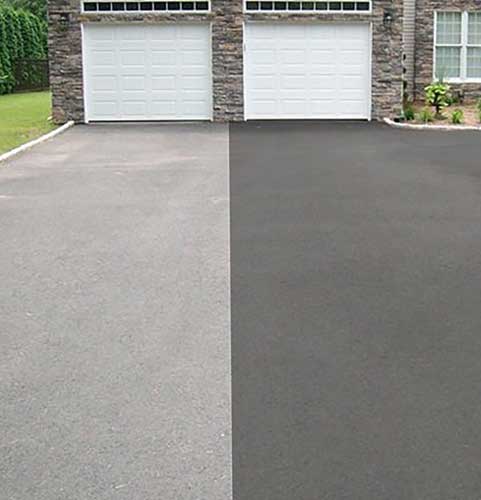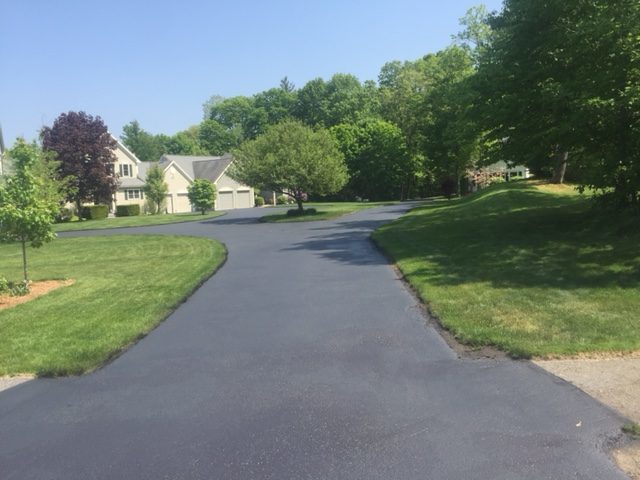Release the Potential: Regrading and Asphalt Sealing for Business Areas
Wiki Article
Hot Mix Asphalt: A Lasting Option for Sidewalk
Hot Mix Asphalt (HMA) has arised as a leading lasting selection for pavement services, supplying a myriad of cutting-edge modern technologies and environmental advantages. As the need for environment-friendly building techniques grows, checking out the subtleties of HMA's sustainability can provide valuable understandings right into the future of sidewalk options.Ecological Benefits of Hot Mix Asphalt

Moreover, Hot Mix Asphalt helps to minimize urban warmth island impacts. Its dark color absorbs sunshine, minimizing the amount of warm reflected back into the ambience compared to lighter-colored sidewalks. This can reduce ambient temperature levels in urban locations, reducing the need for cooling and ultimately decreasing power usage.
On top of that, Hot Mix Asphalt adds to improved stormwater management. Its porous nature enables water to charge and penetrate the sidewalk groundwater supplies, minimizing overflow and the risk of flooding. These environmental benefits make Warm Mix Asphalt a lasting selection for paving roads and highways.
Energy Performance in HMA Production
Is energy effectiveness an essential consider the manufacturing of Warm Mix Asphalt (HMA)? Absolutely. Power plays a considerable role in the production of HMA, influencing both expense and environmental sustainability. One vital aspect of energy performance in HMA production is using warm mix asphalt (WMA) technologies (hot mix asphalt). WMA permits for the blending and positioning of asphalt at lower temperatures contrasted to conventional hot mix asphalt, resulting in reduced energy intake throughout manufacturing. This process not just lowers gas use yet likewise reduces greenhouse gas discharges, making it an extra eco-friendly option.Furthermore, advancements in plant modern technologies have resulted in even more energy-efficient HMA manufacturing processes. Modern plants are designed with functions like recycled asphalt sidewalk (RAP) handling capabilities, efficient burner systems, and improved insulation, all adding to energy savings. By maximizing energy use in HMA manufacturing, the sector can reduce its carbon impact while maintaining high-grade pavement materials. Energy performance is, consequently, an essential consideration in guaranteeing the sustainability of Hot Mix Asphalt manufacturing.
Recyclability of Hot Mix Asphalt
The recyclability of Hot Mix Asphalt (HMA) is an essential element of its sustainability and long-term ecological impact. HMA is one of the most recycled materials in the USA, with over 100 million lots of redeemed asphalt pavement (RAP) being recycled yearly in new pavement building. Recycling HMA provides a number of ecological advantages, such as lowering the demand for virgin materials, reducing energy intake during production, and reducing the amount of waste sent to garbage dumps.The process of reusing HMA entails milling the existing sidewalk, crushing it into smaller pieces, and blending it with brand-new aggregate and asphalt binder to produce a recycled mix. This recycled mix can frequently carry out in addition to or perhaps much better than traditional HMA, while needing less raw materials and producing reduced greenhouse gas discharges. By incorporating RAP right into new sidewalk jobs, roadway companies can save natural deposits, minimize prices, and lessen the environmental impact of roadway construction and upkeep activities. In general, the recyclability of HMA plays a considerable function in promoting sustainable methods within the pavement industry.

Long-Term Efficiency of HMA
Asphalt pavements show resilience and strength over an extensive period, reflecting the lasting efficiency of Warm Mix Asphalt (HMA) The long life of HMA can be attributed to its capability to withstand heavy website traffic loads, rough weather condition problems, and the effects of aging. Studies have actually shown that well-designed and appropriately built HMA pavements can last for 20 years or even more with normal maintenance. The secret to maximizing the long-term performance of HMA hinges on using high-quality materials, complying with finest techniques in construction, and carrying out reliable maintenance approaches. Proper drainage, routine assessments, and timely repair work are vital for preserving the architectural integrity of HMA sidewalks in time. In addition, improvements in HMA modern technology, such as using polymer-modified binders and warm mix asphalt, have additionally enhanced the toughness and durability of HMA pavements. By focusing on top quality building and maintenance methods, HMA proceeds to prove itself as a economical and lasting solution for resilient pavement infrastructure.
HMA: Longevity and Sustainability
Demonstrating both durability and sustainability, Hot Mix Asphalt (HMA) has actually ended up being a cornerstone in the building and construction of resilient sidewalk facilities - commercial parking lot paving. HMA's toughness stems from its capacity to withstand hefty loads, extreme climate condition, and high website traffic volumes, making it a dependable selection for streets, highways, and airport paths. The structure of HMA, which generally consists of accumulations, binder, and filler, plays a critical role in improving its durability and resistance to tear and put on
Moreover, HMA's sustainability lies in its recyclability and energy-efficient manufacturing process. The ability to recycle recovered asphalt sidewalk (RAP) in brand-new HMA blends decreases the demand for virgin products and reduces the ecological effect of pavement construction and upkeep. Additionally, the power effectiveness of producing HMA depends on its reduced mixing temperatures compared to various other pavement materials, leading to reduced energy consumption and greenhouse gas emissions.
Verdict
In final thought, hot mix asphalt (HMA) supplies a sustainable option for pavement with its ecologically pleasant characteristics. HMA's recyclability, power effectiveness in production, and long-lasting longevity make it an environment-friendly option for road angled parking construction.
HMA is one of the most recycled materials in the United States, with over 100 million lots of redeemed asphalt sidewalk (RAP) being reused annually in brand-new pavement building and construction.The procedure of recycling HMA involves crushing the existing pavement, crushing it right into smaller pieces, and blending it with brand-new accumulation and asphalt binder to develop a recycled mix.Asphalt pavements demonstrate durability and durability over an extended duration, showing the long-lasting performance of Hot Mix Asphalt (HMA) In addition, improvements in HMA innovation, such as the use of polymer-modified binders and warm mix asphalt, have actually even more boosted the durability and longevity of HMA pavements. The capacity to reuse redeemed asphalt pavement (RAP) in brand-new HMA combinations reduces the demand for virgin materials and lessens the environmental impact of pavement building and maintenance.
Report this wiki page